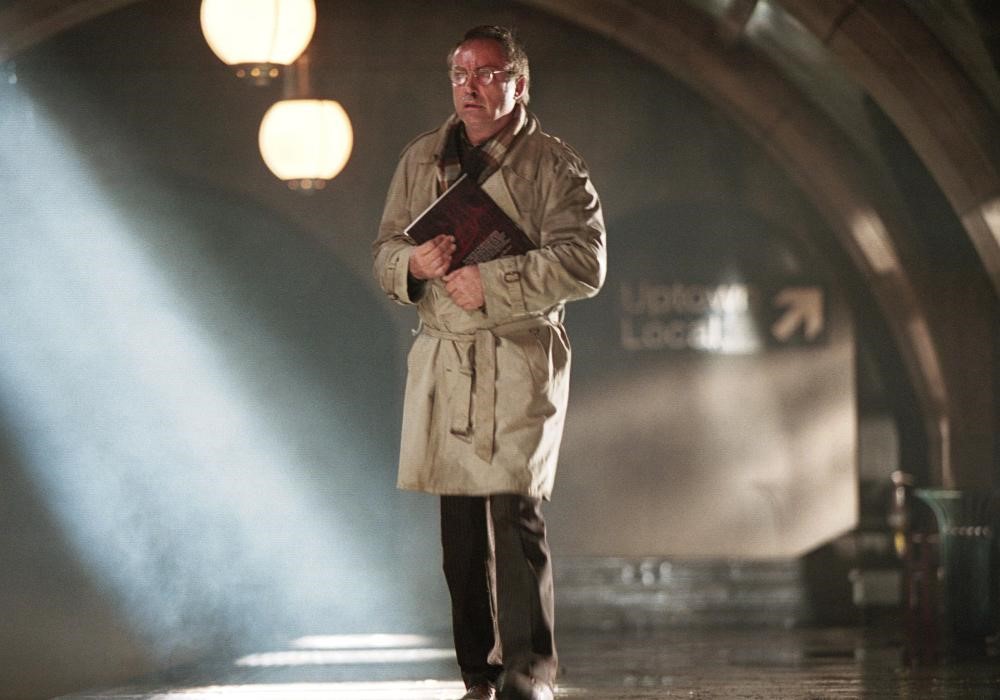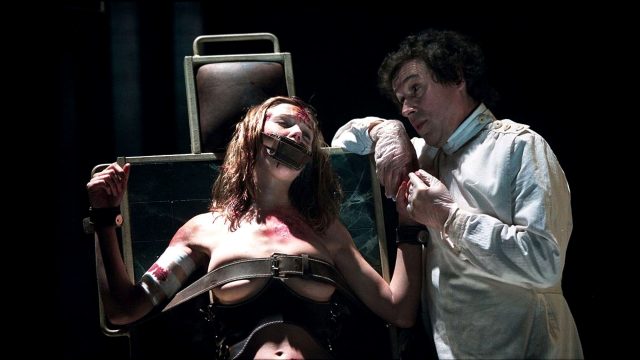Since Cinemascore began operation in 1979 only 19 films have received the lowest score. In this series I’ll be reviewing those 19 films. This week, what’s now a harmless website promoting London prostitution was once a gateway into Hell itself.
So What is it?
To describe the plot of this movie is to give the wrong impression. The story is simple and straightforward, but information is presented to us in a mosaic. Character motivations become clear only after character deaths. Backstory follows climax. Setup follows punchline. Basic character relationships need to be pieced together after the film. The movie plays like a child telling a lie, scrambling to fill in the holes in the story as the audience moves from disbelief to confusion to exasperation before finally settling into mix of amusement and pity.
FearDotCom takes place in New York City, but was filmed Luxembourg. Though many cities and soundstages have doubled for New York over the years, Luxembourg requires an extra level of deception. The whole film is shot in nearly claustrophobic closeups in order to avoid allowing the audience to glimpse any buildings and thereby discover the ruse. The cinematography here is something more than shadowy, bordering on opaque. Though it’s never acknowledged by the film, New York seems to be suffering through a mass evacuation and city wide brownouts.
The film opens with panicked Udo Kier (surprisingly making his only appearance in this series) scurrying across a deserted New York City subway platform. If this subway seems unusually cavernous, it’s because the sets in this movie are recycled from the previous year’s Musketeer, making this post-9/11 New York by way of post-9/11 Luxembourg by way of 17th century France (on a budget). Udo Kier is being chased by a ghost girl, though unlike the J-horror specters that clearly inspired this film, she’s a clean and put-together blonde girl with completely dry and freshly brushed hair, perhaps the least intimidating creature on the planet. Kier is freaked out though and so he runs onto the subway tracks, outrunning the train for a while, before taking refuge in a crevice for a few moments before jumping out in front of the somehow still approaching train and getting hit head-on at full speed.
In the next scene Stephen Dorff (who’s shooting for “haunted veteran detective” with his performance, but comes off more like a junior G-man) shows up to investigate this mystery. Examining Udo Kier’s remarkably un-smooshed body he notes a peculiar look of terror on the man’s face. And not ordinary oncoming-train terror, this is clearly vengeful-ghost terror and thus worthy of a full homicide investigation instead of writing it off as the suicide it so clearly is. The film makes the mistake of showing us Kier’s expression in the first of many shots that would not be out of place in a Naked Gun movie.
Dorff returns to the station as a jabbering German punk is being dragged in, bleeding from the face, and rushes off to investigate the man’s apartment. Once there, he is introduced to the film’s protagonist proper, Natascha McElhone (who between this and Solaris was having a rough year). McElhone is with the department of health, although in the next scene seems to be Dorff’s partner, and by the scene after that his closest and dearest companion in this harsh and dimly lit world. The two discover a corpse and start pawing around the murder scene with their bare hands, before being called back to the precinct where the German has died and is being taken out by a hazmat team.
We’re just hurtling through plot here. We haven’t even properly introduced our leads, and we’re already starting in on our fourth victim. At this point the movie starts crosscutting with its other plot line, as Stephen Rea’s hammily disturbed doctor kidnaps a woman and tortures her, broadcasting the ordeal on his Demonlover-esq website. We will find out later, when we visit Wikipedia, that Dorff has been chasing this doctor for some time now and is haunted by his failure to apprehend him. Justifiably so, since the mad doctor is making no attempt to hide his identity and is recording and broadcasting his crimes live as he commits them.
Next McElhone goes to talk to her boss, and then he gets murdered by his car. It turns out he owned a computer, and Dorff spots a pattern. Dorff treats computers in this movie the way characters treat the puzzle boxes in Hellraiser, like some strange exotic thing that draws an instinctual mix of fear, disgust, and unholy attraction out of him. Every time he says the word he hits it with a slight over emphasis, as though he’s being extra careful to pronounce an unfamiliar term. He delivers the line, “We got to get these computers checked out!” with the same inflection as Steve Martin proclaiming, “This guy hates cans!”
Dorff takes the com-pu-ters to a friend of his, a young woman that seems to be a police officer but also works out of her palace ballroom-sized apartment. She discovers the titular Feardotcom. com. A website that even with today’s high tech fast speed computing machines would take hours to buffer, and would absolutely crash any computer that this production could afford.
Feardotcom. com was of course not the first choice for the website’s name, but since the producers owned neither the fear. com domain name nor a thesaurus, this was the compromise we are stuck with.
Dorff is familiar with the site, because the evil doctor has used the domain before, although no one from the police department has been monitoring it. Or perhaps they have, and that’s the reason the precinct is so deserted. The computer expert begins to be hounded by hallucinations of insects, and kills herself before the 48 hour deadline. The movie never really lays out its premise, but by now all of the characters have deduced it. Log on to feardotcom. com and die 48 hours later. Dorff logs on to the site and takes it worse than most, needing to be immediately hospitalized. McElhone decides the only way to save a coworker she’s met less than two days ago is to also get herself murdered by a demon, and so she logs on to the site as well.
McElhone, thinking outside the box, decides to investigate the woman in the website what that has been haunting everybody, and makes quick progress on the case. She discovers the woman was one of Stephen Rea’s victims. Talking with the woman’s mother, who owns the only working lamp in New York City, she learns that she is also the little blonde ghost. A hemophiliac who liked to play at an abandoned steel mill as a child, and who later survived 48 hours of knife torture. (Well, survived 47 hours of knife torture). One wonders if the screenwriters know what the term “hemophiliac” means. McElhone goes to the steel mill and finds her body, and inside her body finds the address to Stephen Rea’s torture dungeon.
Look, I’m no expert in the ghost business, but it seems like of you’re going to go to all the trouble of setting up a demonic website, you might as well just put that information on it. There’s no need to overthink this stuff, a simple “about us” section could have saved a lot of ectoplasm. But hey, I’m just layman here.
With Dorff back on his feet the two rush to the location, calling Dorff’s rarely-seen actual partner, screen legend Jeffrey Combs, to meet them there.
This leads to some remarkably bad police work. Our two heroes have the unarmed doctor cornered. He momentarily distracts them by revealing Jeffrey Combs’s crucified body, which has been right in the middle of the room in full view of the characters but gone miraculously unnoticed by this pair of crack detectives. They’re more or less nonplussed by this development and Dorff shoots the doctor in the leg, but somehow manages to get shot himself, and McElhone finds herself strapped to the operating table. Dorff, though fatally wounded has time to log on to Feardotcom. com, and the ghost takes her revenge on the doctor, sparing our heroes, although Dorff has gotten himself killed all on his own.
So Why the F?
Probably because the movie is incoherent. Or perhaps it’s a reaction to the generally miserablist tone. Or the cheap low-fi presentation. Or because Feardotcom. com is a stupid name for a website. Or maybe everybody was mad that Jeffrey Combs wasn’t given more to do.
So Were they right?
There’s two reasons why FearDotCom doesn’t deserve an F. The first is that whether you like it or not, this film was ahead of it’s time in quite a few ways. Although it’s difficult to believe, this movie actually predates both The Ring and Demonlover. It doesn’t predate Ringu of course, but this is one of the first American (or Luxembourgian) horror films to start ripping off J-horror. It also anticipates the rise of torture-porn. Neither of those are particularly highly regarded as far as genre trends go, but for a movie so roundly rejected by audiences and critics alike, it had its finger far closer to the zeitgeist than anyone wanted to admit.
The second reason Feardotcom doesn’t deserve an F is because it’s a hoot. It’s bad in all the best ways. Aggressively stylistic. Gleefully stupid. Full of memorably dumb dialogue, delivered with gravitas and intensity. Fast paced, not in the “high energy/action packed” sense but in the “we’re only filming every third scene of this script” sense. The acting is engaging, but wonderfully miscalculated. And the whole thing comes in at a brief and breezy hour and 41 minutes. And for what it is, the horror scenes aren’t half bad. Who doesn’t want to see a woman chased around her apartment by swarms of cockroaches, or a man’s car drive itself into a wall, or Udo Kier play cat and mouse with a subway train? Some days all you need is a few misplaced dutch angles and a pitch black police station.

Next Time: We reunite with Ashley Judd and go all the way back to 1999 for Cinemascore’s very first F.

